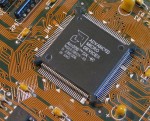I‘ll be honest: I’ve always been partial to AMD’s processors after buying my very first 386 PC clone in the early 90s. I’m pretty sure the PC came with the AMD 386 DX40 processor: at that time, nobody fell for the Intel SX chip trap. Intel chips were too expensive, too slow (intentionally) and mostly, required more power than the AMD processors.
be honest: I’ve always been partial to AMD’s processors after buying my very first 386 PC clone in the early 90s. I’m pretty sure the PC came with the AMD 386 DX40 processor: at that time, nobody fell for the Intel SX chip trap. Intel chips were too expensive, too slow (intentionally) and mostly, required more power than the AMD processors.
AMD, sort of, always surprised the tech. market. While not the first to have created a dual-core processor (that honour befalls IBM of course), they were the first one to put a server-based dual-core chip on the market. Intel, feeling the heat, rushed out a dual-core processor for the desktop market. If I recall correctly, Intel’s form of dual-core processors were literally Pentiums soldered on a single board (with external logic processors) as opposed to AMD, where their Opteron platform was from the get-go designed to support multiple processors on a die (wikipedia).
AMD’s ATI take-over was another surprise. By now, ATI’s technology has literally been integrated into AMD’s processors in the form of AMD’s so-called APU line (wikipedia). That is a feat that has Intel still smoldering for an answer: I mean, technically, their integrated Intel 3000/4000 HD processor was a half-hearted response.
Which brings us to the now: You’ve heard that AMD is going to provide chips for both the PS4 and new Xbox. AMDs long goal and plan has always been to move the FPU to the GPU leaving the main CPU just for integer processing (reddit discussion), not to much success and adoption from developers though. Now that both Microsoft and Sony are adopting AMD’s chips and the possibility of true cross-platform game development this is going to change. I have this feeling that nVidia will somehow end up in Intel’s hands. Not that it will help Intel, now that the market seems to be going towards low-powered CPUs. Nvidia’s only good move was to branch out to the mobile market with their RISC-based Tegra line.
